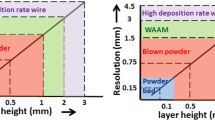Abstract
Additive manufacturing of components, layer-by-layer, offers several advantages compared to conventional production technologies such as higher material utilization efficiency and increased geometric possibilities. Arc-based additive manufacturing processes have the additional advantage of an almost unlimited assembly space, higher deposition rates, and an improved utilization factor of raw materials. Up to now, the gas metal arc welding variant, cold metal transfer (CMT), and other wire-based process combinations have been used predominantly in this field. Disadvantages of wire-based methods are the restricted availability of different types of wire consumables, the wire feed rate directly coupled to the heat input, and the lack of possibility to create multi-material structures with one heat source in-situ. Within this work, the 3D plasma-metal deposition (3DPMD) method, based on a plasma powder deposition process is introduced. 3DPMD has some advantages compared to the established plasma powder process and wire-based CMT process. Basis for this evaluation is the production of geometrically complex structures by the different methods (CMT & 3DPMD) and their subsequent characterization. Structures are fabricated using welding robots with the path control directly generated from the CAD files. In summary, 3DPMD offers increased flexibility in terms of material selection as well as the possibility to build graded structures. By using subroutines realized from a special postprocessor, it is possible to generate metal structures with standard welding robots directly from the CAD drawings. Microstructures and properties are directly related to the process and therefore material-process-property relationships are discussed within this work.








Similar content being viewed by others
References
Brandl E, Baufeld B, Leyens C, Gault R (2010) Additive manufactured Ti-6Al-4V using welding wire: comparison of laser and arc beam deposition and evaluation with respect to aerospace material specifications. Phys Procedia 5:595–606. https://doi.org/10.1016/j.phpro.2010.08.087
NN: “x-Technik - Additive Fertigung”, journal, 01/2015; Link: x-technik IT & Medien GmbH; http://www.x-technik.at/fachbereiche/additive_fertigung.php#anchor_ausgaben
Almeida S, Williams S. “Innovative Process model of Ti6Al4V AM unsing CMT”. Proceedings of the 21st annual international freeform fabrication, 2014. Austin
Martina F, Mehnen J, Williams SW, Colegrove P, Wang F (2012) Investigation of the benefits of plasma deposition for the additive layer manufacture of Ti–6Al–4V. J Mater Process Technol 6:1377–1386
Guenther K, Henckell P “Wire based additive manufacturing with GMAW – Research on temperature and time towards homogeneous material properties”. Conference proceedings, IIW 2017, Shanghai. Doc. I-1306-17/XII-2359-17
Röhrich T, Riemann A “The potential of the wire-arc based 3DMP process for rapid manufacturing”. Conference proceedings, ICWAM 2017, Metz, WIRE-AM-02
Schoerghuber M (2016) “Using innovative CMT process for industrial applications”. Conference proceedings, Kolkata
Matthes K-J, Richter E (2006) “Schweißtechnik –Schweißen von metallischen Konstruktionswerkstoffen”. 3.Auflage, Hanser Verlag
NN (2006) “Hinweise zum Schweißen ferritisch - austenitischer Stähle (Duplex / Super-Duplex)”. ESAB- OK-Handbuch – Teil Duplexstähle
Standard EN ISO 1011-2 (2001) Welding—Recommendations for welding of metallic materials—Part2: Arc welding of ferritic steels. Beuth Verlag GmbH
Strassburg F (2000) “Schweißen nichtrostender Stähle”. DVS-Verlags GmbH
Muthupandi V, Srinivasan P, Seshadri S, Sundaresan S (2003) Effect of weld metal chemistry and heat input on the structure and properties of duplex stainless steels. Mater Sci Eng 358(1-2):9–16. https://doi.org/10.1016/S0921-5093(03)00077-7
Standard EN ISO 13916 (1996) “Guidance on the measurement of reheat temperature, interpass temperature and preheat temperature”. Beuth Verlag GmbH
DVS 0946 “Empfehlungen zum Schweißen von nichtrostenden austenitisch-ferritischen Duplex- und Superduplexstählen”. Deutscher Verband für Schweißen und verwandte Verfahren e.V.; DVS Verlag, Februar 2004
Taban E (2008) Toughness and microstructural analysis of superduplex stainless steel joined by plasma arc welding. J Mater Sci 43(12):4309–4315. https://doi.org/10.1007/s10853-008-2632-z
Posch G, Chladil K (2017) Material properties of CMT—metal additive manufactured duplex stainless steel blade-like geometries. Weld World 61(5):873–882. https://doi.org/10.1007/s40194-017-0474-5
Kaluc E, Taban E (2011) Welding behaviour of duplex and superduplex stainless steels using laser and plasma arc welding processes. Weld World 55(7–8):48–57. https://doi.org/10.1007/BF03321307
Author information
Authors and Affiliations
Corresponding author
Additional information
This article is part of the collection Welding, Additive Manufacturing, and Associated NDT
Rights and permissions
About this article
Cite this article
Hoefer, K., Haelsig, A. & Mayr, P. Arc-based additive manufacturing of steel components—comparison of wire- and powder-based variants. Weld World 62, 243–247 (2018). https://doi.org/10.1007/s40194-017-0527-9
Received:
Accepted:
Published:
Issue Date:
DOI: https://doi.org/10.1007/s40194-017-0527-9




